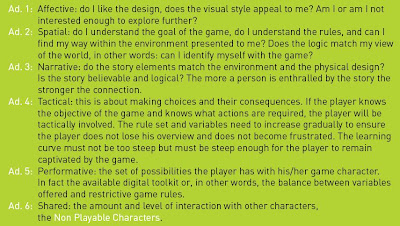Reading a book can be like following a path of unique field knowledge and insights. I remember discovering the strange fields of math, or learning about the rules of creation in 3d programs. However, although a book interacts with you in terms of its ideas, which challenges you, you remain a relatively passive participant. This affects the learning process, which are at the risk of being weakened, as the participant quickly and easily can lose motivation. After all, the initial motivation that makes a person open a book, watch a TV program or listen to the radio, might change: Leaving the participant with no reasons for continuing the learning process.
A Brand New Playground gives life to the idea that the best games succeed in creating a highly beneficial learning curve by making the participant engage in the process – and thus “wake up”! A Brand New Playground proposes: “Where watching a movie is a relaxing activity where you can lean back or even slump on the couch, you are a passive participant; a game generally requires active consumer participation and generates a high level of involvement – stronger yet: the person playing the game even dictates the course and outcome of the game!”
The above quote meets further scientific backup, stating that indeed game offers a unique way of learning, which potential is hidden in its ability to involve players: "Active involvement in video game play sparks positive motivation in a way that watching and hearing information does not," says Steve Cole, Ph.D., Vice President of Research and Development at HopeLab, professor of medicine at the University of California, Los Angeles, and co-author of the article. He continues: "All participants in the study received the same information. It was the active participation in gameplay that made the big difference in motivation. This study helps refine our 'recipe for success' in harnessing the power of play in the service of health."
This statement is part of a study, investigating the effect of a new serious game called Re-Mission, targeted young cancer patients. In Re-Mission players pilot a nanobot named Roxxi as she travels through the bodies of fictional cancer patients destroying cancer cells, battling bacterial infections, and managing side effects associated with cancer and cancer treatment.
As the most essential finding, this study shows how reward-related activation is associated with a shift in attitudes and emotions that has helped boost players' adherence to prescribed chemotherapy and antibiotic treatments in a previous study. Check out the video below to get a first-hand impression and initial opinion on how well the concept has been carried out.
The study compared brain scans in 57 people who were randomly assigned to actively play Re-Mission or to passively watch the same recorded game play (similar to watching a movie, with the exact same information, but no direct participation in the game play events). Results of functional magnetic resonance imaging (FMRI) showed that neural circuits implicated in reward activated strongly while players were actively playing Re-Mission, but not when they were resting, or when other players passively observed the same game play events.
The article on PRWeb.com, despite its slightly exaggerated nature, gives some relevant insights: This and other recent studies could prove a change in how both game developers and health care professionals think of games as a learning tool. As a growing body of research data shows that digital games can positively alter the players’ attitude and behavior, the interest and realized potential of "serious games" and "games for health" is gradually increasing. Although the main idea has existed for a long time – the idea that games’ ability to involve players improves motivation and thus learning – the added scientific value of such studies should not be underestimated, when health care institutions and governments consider games as a way of reaching their goals.
In A Brand New Playground there is a reference to the work of Gordon Calleja analyzing the aspects of involvement. These aspects are affective involvement, spatial involvement, narrative involvement, tactical involvement, performative involvement and shared Involvement. Looking at the game through the lenses of these various terms, can help us understand the effect of Re-Mission.
Spatial and tactical involvement is particularly important, because the rules that required you to win and the tactical understanding of the game, is inevitably related to the way the treatment of the patients/players works. Furthermore the similarity between the game story and the real-life situation of patients/players, makes narrative involvement especially strong, as participants can identify with the feelings of fighting cancer. It is not an option to interact with other players/patients in-game – however shared involvement can be expected to happen outside of the frames of the game, as patients most likely will discuss the game with other friends, who are in a similar situation as themselves.
Re-Mission was developed by non-profit organization HopeLab, specialized in the improving the health of young people through new technology. The game has distributed more than 185,000 free copies of Re-Mission in 81 countries worldwide since its release in April 2006.




No comments:
Post a Comment